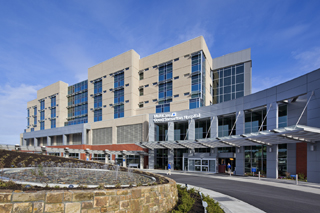|
Subscribe / Renew |
|
|
Contact Us |
|
| ► Subscribe to our Free Weekly Newsletter | |
| home | Welcome, sign in or click here to subscribe. | login |
Construction
| |
 |
June 23, 2011
Puyallup hospital tower puts focus on patients
Clark/Kjos Architects and GBJ Architecture

Clark
|

Giffin
|
MultiCare Health System’s Good Samaritan Hospital in Puyallup is transitioning from a community hospital to a regional medical center. The leaders at Good Samaritan had a vision for a hospital where the patient is at the center of care, the family feels welcomed and the facility operates efficiently.
“Our guiding commitment was to design a new hospital that focused on the patient experience, that was a very functional building of quality, and that was finished on budget, on schedule, and safely,” said Allison Garr, MultiCare’s administrator for campus development.
In 2006, the Good Sam Collaborative was commissioned to lead the design and construction team in making the client’s vision a reality. The firms forming this joint venture, GBJ Architecture and Clark/Kjos Architects, each specialize in designing health care facilities and are usually competitors.
Their combined employees worked together as a single firm to complete a new hospital facility. The client sought to give the hospital a position of prominence in its community, create a hospital expansion that put patients and their families “in the center” of the care process, and provide the highest level of medical care using the latest technology and care-delivery concepts.
Patient-centered care
The new Patient Care Tower at Good Samaritan opened in February. The nine-story, 357,000-square-foot building is a slender tower located on a hill, providing prominence in the community and saving green space.
The tower is oriented to maximize healing views of surrounding mountain ranges. Five different colors of glass create a quilt effect across the facade.
The tower is surrounded by four therapeutic garden spaces as well as a four-story, 380-stall parking structure. A new 12,600-square-foot central utility plant is housed in a two-level building with a tunnel underneath the street connecting utilities to the new tower.
The client’s philosophy to put the patient and family at the center of care inspired the building’s architecture, operational structuring and interior design. The design team sought new ways to help people navigate a complex system within a warm and comfortable environment.
The new entrance and central hub connects old and new hospital buildings seamlessly and expresses the philosophy of a patient-centered experience. The light-filled hub has greeters, information displays, registration, meditation space, food and retail.
“In order for us to deliver patient-centered care, we needed to create an environment in which people feel honored, respected and assured,” Garr said.
| Good Samaritan Hospital |
|
MultiCare Health System, Tacoma Architects: Clark/Kjos Architects, Portland and Seattle; GBJ Architecture, Portland General contractor: Skanska USA Building, Seattle Civil/structural engineer: ABKJ, Seattle Mechanical engineer: CDi Engineers, Lynnwood Electrical engineer: Sparling, Seattle Landscape architect: Walker Macy, Portland |
”We tried to think through every support system that exists for the patient, family and staff.”
Interiors by Clark/Kjos Architects were designed to minimize patient and family stress while adding to wellbeing and conveying high-quality care. The new tower is flooded with daylight from windows, filled with warm natural wood, and punctuated with colorful light fixtures, tiles and artwork.
Patient-centered treatment begins at the central hub with an innovative “express services” concept. This new concept places high-volume outpatient services — imaging, testing, presurgical clinic and ambulatory treatment — adjacent to the main lobby to create a welcoming, non-institutional atmosphere.
Benefits include easier access (outpatients can bypass elevators and hospital corridors), more efficient organization of departments and technology, and direct connection to the main circulation spine for movement of staff and patients. Surgery waiting is connected via an open stair and atrium to a grander lobby and coffee bar, allowing family members to move between different low-stress settings while maintaining connections.
A key feature for patient-centered care includes separate circulation routes for public and staff, which honors patient experience and minimizes staff travel distances. Other features include dedicated patient room zones for family members, and decentralized, technology-supported staff stations that keep caregivers close to patients in inpatient and diagnostic areas.
Green features
The tower is the first hospital in Washington registered with the U.S. Green Building Council’s LEED program, and is on track to receive a silver certification.
The building and parking structure replaced surface parking lots and a public street, and also replaced impervious surfaces with permeable green space. The structures added no new impacts to the stormwater system.
Other sustainable features include:
• Ecoroofs, bioswales and rain gardens that gather stormwater runoff.
• An energy-efficient building form that minimizes east-west exposure; sun shades on the windows to reduce heat gain.
• Renewable, recycled and regionally sourced materials; certified wood, low-VOC interior finishes and linoleum and rubber flooring.
• Reduction of potable water use by 20 percent compared with a normal hospital.
• HVAC system with low-velocity ducting, high-efficiency chillers and mid-building air handlers.
• Air drawn 100 percent from outside the building to help control infections, and a heat-recovery system to conserve energy.
A zoning victory
The project required high levels of cooperation among the client group, members of the design and construction team, and city and state agencies.
For example, the site’s 90-foot elevation change provided a natural obstacle, and the new facility needed to connect with and relate to the existing hospital building. To utilize the site’s topography, as well as for efficiency and connectivity, the new hospital needed to be stacked. However, the city of Puyallup’s site zoning limited building height to 70 feet.
The team gained approval for a 160-foot building from the city, which waived the 70-foot height limit. The building’s “step back” design rests a thinner, visually scaled-back tower on a larger base.
Consolidating the square footage into a slender tower realized significant benefits such as more daylight inside, with windows closer to patients and staff, and access to expansive views. The compact footprint maximizes green space on the site, leaving open space for the community to enjoy, as well as patients, visitors and staff.
The collaborative team approach was key to meeting budget and schedule. Total elapsed time, including master planning, programming, design and construction was slightly over three years, which is extremely aggressive for a project of this size.
“The cooperative nature of the entire team allowed us to deliver the project in multiple phases, providing patient care to the community sooner,” said Ed Thenell, the senior director of project management at CB Richard Ellis.
The team worked with staff co-located in on-site offices throughout design and construction. The entire project was designed in Revit, the first time either firm had used building-information modeling (BIM) software.
“Sharing BIM allowed us to discover any conflicts prior to construction,” said Mark Howell, a senior vice president for Skanska USA Building.
“It eliminated delays we would otherwise have encountered if we had not been working the project virtually prior to actual construction.”
With its design focused on patient-centered care, Good Samaritan’s new patient tower is changing the face of health care for residents of East Pierce County. The team’s willingness to collaborate has created a beautiful hospital building and expanded campus, bringing the best available care to the community.
Tom Clark is a principal with Clark/Kjos Architects, and Herb Giffin is a principal with GBJ Architecture.
Other Stories:
- 13 tips for choosing your medical space
- Study will help UW’s Montlake Tower cut energy costs
- Swedish Issaquah aligns design with patient needs
- Good signage points the way to better health care
- 'Novel' process lets Swedish Issaquah hit fast forward
- ‘Hybrid’ rooms a low-cost answer to space needs
- Swedish women’s cancer center a one-stop shop
- Group Health is designing its clinic of the future
- Evergreen opens center closer to its patients
- New VA complex to treat ‘emerging’ war injuries
- Friday Harbor hospital aims to be nation’s greenest
- UW expansion stays on track despite big change in plans



